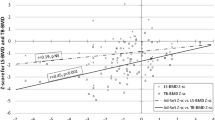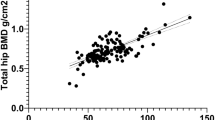Abstract
Bone loss after kidney transplantation is a significant complication of immunosuppressive treatment leading to a high prevalence of bone fracture in these patients. The purpose of this study was to determine the usefulness of quantitative ultrasound (QUS) of the calcaneus in comparison with dual X-ray absorptiometry (DXA) of the lumbar spine in determining bone status and mineral changes in patients in the first 6 months after transplantation. Forty-six patients participated in the study (25 men and 21 women; age range 26–62 years, 102±66 months previously on dialysis). They were treated with cyclosporine, methylprednisolone, mycophenolate mofetil, and basiliximab. The 6-month cumulative steroid dose was 24.9±3.7 mg/kg body weight. Calcaneal QUS (Sahara, Hologic, Waltham, Mass.) and DXA (Hologic QDR 4500) of the lumbar spine were done in all patients within 3 weeks after transplantation and 6 months thereafter. Bone mineral density (BMD) of the lumbar spine measured by DXA decreased from 0.892±0.137 to 0.837±0.126 g/cm2 (p<0.0001) and the T score decreased from 1.84±1.29 standard deviation (SD) to 2.35±1.19 SD (p<0.0001) in the first 6 months after transplantation. The QUS parameters of the calcaneus were broadband ultrasound attenuation (BUA), speed of sound (SOS), and quantitative ultrasound index (QUI). The QUS parameters did not change significantly after the first 6 months. All QUS parameters correlated significantly with DXA BMD of the lumbar spine immediately after transplantation and 6 months thereafter. Significant decrease of the lumbar spine BMD in the first 6 months after transplantation was not accompanied by significant changes of calcaneal QUS parameters. The calcaneal QUS does not reflect bone mineral changes occurring in the lumbar spine and could not be a substitute for a direct-site DXA of the lumbar spine in the early period after kidney transplantation.



Similar content being viewed by others
References
Julian BA, Laskow DA, Dubovsky J, Dubovsky EV, Curtis JJ, Quarles LD (1991) Rapid loss of vertebral mineral density after renal transplantation. N Engl J Med 325:544–550
Horber FF, Casez JP, Steiger U, Czerniak A, Montandon A, Jaeger P (1994) Changes in bone mass early after kidney transplantation. J Bone Miner Res 9:1–9
Baylink DJ (1983) Glucocorticoid-induced osteoporosis. N Engl J Med 309:306–308
Wolpaw T, Deal CL, Fleming-Brooks S, Bartucci MR, Schulak JA, Hricik DE (1994) Factors influencing vertebral bone density after renal transplantation. Transplantation 58:1186–1189
Thiebaud D, Krieg MA, Gillard-Berguer D, Jacquet AF, Goy JJ, Burckhardt P (1996) Cyclosporine induces high bone turnover and may contribute to bone loss after heart transplantation. Eur J Clin Invest 26:549–555
Grotz WH, Mundinger FA, Gugel B, Exner VM, Kirste G, Schollmeyer PJ (1994) Bone fracture and osteodensitometry with dual energy X-ray absorptiometry in kidney transplant recipients. Transplantation 58:912–915
Torres A, Machado M, Concepcion TM et al. (1996) Influence of vitamin D receptor genotype on bone mass changes after renal transplantation. Kidney Int 50:1726–1733
Pocock NA (1998) Quantitative diagnostic methods in osteoporosis: a review. Australas Radiol 42:327–334
Njeh CF, Boivin CM, Langton CM (1997) The role of ultrasound in the assessment of osteoporosis: a review. Osteoporosis Int 7:7–22
Peretz A, Penaloza A, Mesquita M, Dratwa M, Verhas M, Martin P, de Maertelaer V, Bergmann P (2000) Quantitative ultrasound and dual X-ray absorptiometry measurements of the calcaneus in patients on maintenance hemodialysis. Bone 27:287–292
Montagnani A, Gonnelli S, Cepollaro C, Martini S, Finato V, Paolo N di, Bellucci G, Gennari C (1999) Quantitative ultrasound in the assessment of skeletal status in uremic patients. J Clin Densitom 2:389–395
Penaloza A, Peretz A, Mesquita M, Dratwa M, Bergmann P (1998) Quantitative ultrasound bone measurement and dual X-ray absorptiometry in the assessment of bone disease in patients with terminal chronic renal failure. Osteoporosis Int 8 (Suppl 3):57
Kosch M, Hausberg M, Link T, Kemkes M, Barenbrock M, Dietl KH, Matzkies F, Rahn KH, Kisters K (2000) Measurement of skeletal status after renal transplantation by quantitative ultrasound. Clin Nephrol 54:15–21
Tromp AM, Smit JH, Deeg DJH, Lips P (1999) Quantitative ultrasound measurements of the tibia and calcaneus in comparison with DXA measurements at various skeletal sites. Osteoporosis Int 9:230–235
Rosenthal L, Caminis J, Tenenhouse A (1996) Correlation of ultrasound velocity in the tibial cortex, calcaneal ultrasonography, and bone mineral densitometry of the spine and femur. Calcif Tissue Int 58:415–418
Giorgino R, Paparella P, Larusso D, Mancuso S (1996) Effects of oral alendronate treatment and discontinuance on ultrasound measurements of the heel. J Bone Miner Res 11 (Supp 1):S341
Gonnelli S, Cepollaro C, Pondrelli C (1996) Ultrasound parameters in osteoporotic patients treated with salmon calcitonin: a longitudinal study. Osteoporosis Int 6:303–307
Giorgino R, Paparella P, Larusso D, Mancuso S (1997) Longitudinal effects of three hormonal replacement therapies on quantitative ultrasound bone measurement. J Bone Miner Res 12 (Suppl 1):S103
Rosenthall L, Caminis J, Tenehouse A (1999) Calcaneal ultrasonometry: response to treatment in comparison with dual X-ray absorptiometry measurements of the lumbar spine and femur. Calcif Tissue Int 64:200–204
Nisbeth U, Lindh E, Ljunghall S, Backman U, Fellstrom B (1994) Fracture frequency after kidney transplantation. Transplant Proc 26:1764
Johansen A, Stone MD (1997) The effect of ankle oedema on bone ultrasound assessment at the heel. Osteoporosis Int 7:44–47
Daens S, Pertz A, De Maertelaer V, Moris M, Bergmann P (1999) Efficiency of quantitative ultrasound measurements as compared with dual-energy X-ray absorptiometry in the assesment of corticosteroid-induced bone impairment. Osteoporos Int 10:278–283
Madsen OR, Egsmose C, Hansen B, Srensen OH (1998) Soft tissue composition, quadriceps strength, bone quality and bone mass in rheumatoid arthritis. Clin Exp Rheum 16:27–32
Mondry A, Hetzel GR, Willers R, Feldkamp J, Grabensee B (2001) Quantitative heel ultrasound in assessment of bone structure in renal transplant recipients. Am J Kidney Dis 37:932–937
Gler CC (1999) Monitoring skeletal changes by radiological techniques. J Bone Miner Res 14:1952–1962
Gonnelli S, Cepollaro C, Montagnani A, Martini S, Gennari L, Mangeri M, Gennari C (2002) Heel ultrasonography in monitoring alendronate therapy: a four-year longitudinal study. Osteoporos Int 13:415–421
Acknowledgements
We thank M. Čalić, E. Jovanović, R. Marinković, A. Zver, and E. Stepanovič for their contributions to the measurements and administrative work.
Author information
Authors and Affiliations
Corresponding author
Rights and permissions
About this article
Cite this article
Kovač, D., Lindič, J., Kandus, A. et al. Quantitative ultrasound of the calcaneus and dual X-ray absorptiometry of the lumbar spine in assessment and follow-up of skeletal status in patients after kidney transplantation. Osteoporos Int 14, 166–170 (2003). https://doi.org/10.1007/s00198-002-1360-5
Received:
Accepted:
Published:
Issue Date:
DOI: https://doi.org/10.1007/s00198-002-1360-5




